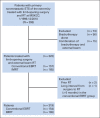Comparison of local recurrence with conventional and intensity-modulated radiation therapy for primary soft-tissue sarcomas of the extremity
- PMID: 25185087
- PMCID: PMC4178522
- DOI: 10.1200/JCO.2013.53.9452
Comparison of local recurrence with conventional and intensity-modulated radiation therapy for primary soft-tissue sarcomas of the extremity
Abstract
Purpose: The use of intensity-modulated radiation therapy (IMRT) in the treatment of soft tissue sarcoma (STS) of the extremity is increasing, but no large-scale direct comparison has been reported between conventional external-beam radiation therapy (EBRT) and IMRT.
Methods: Between January 1996 and December 2010, 319 consecutive adult patients with primary nonmetastatic extremity STS were treated with limb-sparing surgery and adjuvant radiotherapy (RT) at a single institution. Conventional EBRT was used in 154 patients and IMRT in 165 with similar dosing schedules. Median follow-up time for the cohort was 58 months.
Results: Treatment groups were comparable in terms of tumor location, histology, tumor size, depth, and use of chemotherapy. Patients treated with IMRT were older (P = .08), had more high-grade lesions (P = .05), close (< 1 mm) or positive margins (P = .04), preoperative radiation (P < .001), and nerve manipulation (P = .04). Median follow-up was 90 months for patients treated with conventional EBRT and 42 months for patients treated with IMRT. On multivariable analysis adjusting for patient age and tumor size, IMRT retained significance as an independent predictor of reduced LR (hazard ratio = 0.46; 95% CI, 0.24 to 0.89; P = .02).
Conclusion: Despite a preponderance of higher-risk features (especially close/positive margin) in the IMRT group, IMRT was associated with significantly reduced local recurrence compared with conventional EBRT for primary STS of the extremity.
© 2014 by American Society of Clinical Oncology.
Conflict of interest statement
Authors' disclosures of potential conflicts of interest and author contributions are found at the end of this article.
Figures


Comment in
-
[Superiority of IMRT over conventional 3D-EBRT even with local control of the extremity].Strahlenther Onkol. 2015 Apr;191(4):382-3. doi: 10.1007/s00066-015-0813-7. Strahlenther Onkol. 2015. PMID: 26079026 German. No abstract available.
References
-
- Pisters PW, Harrison LB, Leung DH, et al. Long-term results of a prospective randomized trial of adjuvant brachytherapy in soft tissue sarcoma. J Clin Oncol. 1996;14:859–868. - PubMed
-
- Yang JC, Chang AE, Baker AR, et al. Randomized prospective study of the benefit of adjuvant radiation therapy in the treatment of soft tissue sarcomas of the extremity. J Clin Oncol. 1998;16:197–203. - PubMed
-
- Alektiar KM, Brennan MF, Singer S. Local control comparison of adjuvant brachytherapy to intensity-modulated radiotherapy in primary high-grade sarcoma of the extremity. Cancer. 2011;117:3229–3234. - PubMed
-
- Alektiar KM, Velasco J, Zelefsky MJ, et al. Adjuvant radiotherapy for margin-positive high-grade soft tissue sarcoma of the extremity. Int J Radiat Oncol Biol Phys. 2000;48:1051–1058. - PubMed
-
- Hong L, Alektiar KM, Hunt M, et al. Intensity-modulated radiotherapy for soft tissue sarcoma of the thigh. Int J Radiat Oncol Biol Phys. 2004;59:752–759. - PubMed
Publication types
MeSH terms
Grants and funding
LinkOut - more resources
Full Text Sources
Other Literature Sources
Medical

